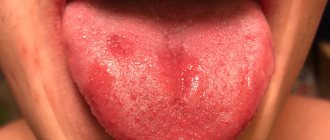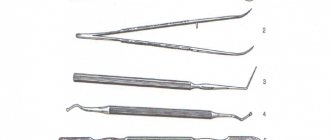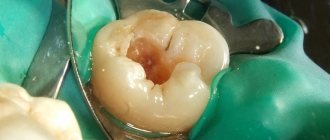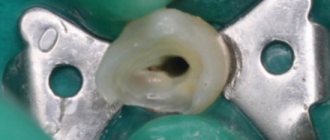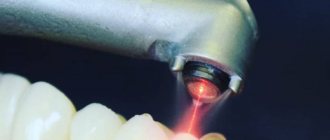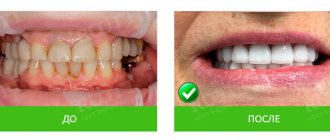What is a dental emergency?
Emergency dental care is understood as medical care provided for acute diseases, painful conditions, exacerbation of chronic diseases WITHOUT obvious signs of a threat to life, delaying the provision of which for an indefinite period of time will lead to a deterioration in the patient’s condition. Medical services can be provided in an outpatient setting.
Conditions requiring emergency dental care include:
- pulpitis (acute or exacerbation of chronic)
- periodontitis (acute and exacerbation of chronic)
- maxillofacial injuries (such as a dislocated or fractured tooth)
- exacerbation of odontogenic and non-odontogenic inflammatory diseases of the maxillofacial area
- stomatitis
- other acute painful conditions
- treatment requiring surgery
Emergency dental care can be provided both in a public dental clinic and in a private dental office.
And today we’ll talk about acute conditions of patients, sometimes arising at the mere sight of a dentist. What kind of help should be given in this case? Vyacheslav TAKOEV, dentist-implantologist, chief physician of the Victoria LLC clinic, specialist in “dental phobias”, full member of the Russian Dental Associations, talks about this:
– Most often, during an outpatient dental appointment, patients develop collapse - acute vascular insufficiency, usually called syncope. It can occur in both vertical and horizontal positions. In most cases, it is iatrogenic in nature: a painful examination, pain from manipulations, including injections of local anesthetic, puncture of a vein, the sight of blood, etc. In those who are especially sensitive, collapse develops from one type of doctor and medical equipment. This kind of anxiety in the patient causes a decrease in heart rate, a decrease in vascular tone, which entails a redistribution of blood in the body due to a sharp expansion of the vascular bed and leads to bleeding of the brain.
Signs of approaching collapse are the patient's complaints of nausea, weakness, sometimes suffocation, and sudden thirst. The skin becomes pale, covered with perspiration, the pulse in the peripheral arteries is threadlike or absent, blood pressure when measured by the indirect method is sharply reduced or not determined. Loss of consciousness is accompanied by uncoordinated movements of the eyeballs, dilated pupils, and convulsions.
According to the stage of collapse, therapy should be gradual. The first thing to do is to place the patient in the so-called “Trendelenburg position,” in which the pelvis and lower limbs are located above the head. This will ensure blood flow to the brain. It is incorrect to bend the patient forward from a sitting position. Some dentists justify this action on the grounds that a confused patient lying on his back may “inhale” the contents of the oral cavity. However, bending leads to increased intra-abdominal pressure, which negatively affects blood circulation.
Next, to bring you out of a fainting state, carefully bring a piece of gauze moistened with an ammonia solution to your nose. In most cases, these measures are sufficient to stop the acute condition.
Exacerbation of hypertension. A rise in blood pressure above 140/90 millimeters of mercury by 40–50 millimeters in a person suffering from hypertension is called a hypertensive crisis.
A common occurrence at a dental appointment is arterial hypertension, which, by the way, should be distinguished from hypertensive crises.
To diagnose these conditions, it must be borne in mind that a hypertensive crisis (exacerbation of hypertension) is characterized by the presence of this disease in the anamnesis. Possible headaches in the occipital region, nausea, vomiting, numbness of the lips, forehead, facial flushing, flickering of spots before the eyes, and confusion.
The danger of hypertensive crises lies in the possible acute damage to target organs. Regional circulatory disorders are defined as acute hypertensive encephalopathy, stroke, acute coronary and acute heart failure. Therefore, such a patient must be urgently transferred to a called ambulance team, while waiting for it, the patient must be given antihypertensive drugs, for example, Corinfar, every 15 minutes under the tongue (up to 3 tablets), which gradually reduce blood pressure or prevent it from increasing.
Always be healthy!
LLC "Victoria" - st. Pashkovsky, 22.
Tel.: 25-37-62, 8-961-820-20-84.
(As an advertisement.)
What is emergency dental care?
Emergency dental care refers to medical care provided for sudden acute diseases, conditions, exacerbation of chronic diseases that pose a threat to the patient’s life. Such assistance can ONLY be provided within a hospital setting. If, based on the results of the examination, the dentist made an objective decision that it is impossible to provide assistance on an outpatient basis, he has the right to refuse the patient and send him by ambulance to the hospital.
Conditions requiring emergency dental care include:
- cellulitis (an acute bacterial infection of the skin and subcutaneous tissues, most often caused by streptococci or staphylococci)
- abscess
- furuncle
- carbuncle
- osteomyelitis.
- tooth extraction requiring external access
- other conditions for which assistance can only be provided in a hospital setting
Emergency conditions in dentistry: how to cope with them? (Lectures, Dentistry)
Program
General understanding of emergency conditions in dental practice
- Definition of an emergency
- Legal aspects of providing and not providing assistance in emergency conditions in dentistry
- When and how often do emergencies occur?
- Stress as the main cause of emergency conditions
- Mechanisms for implementing stress reactions
- Decompensation of chronic diseases due to stress
- Principles of proper history taking
- Determining the Risk of a Dental Procedure
- Rating scales for assessing the risk of developing emergency conditions
- Situational tasks
- General principles of differential diagnosis
- The principle of analysis of emergency conditions in dentistry based on leading symptoms
Symptom of loss of consciousness
- Frequency of loss of consciousness in dental practice
- Risk factors for developing syncope
- Danger of loss of consciousness
- Causes and mechanisms of loss of consciousness
- Hypovolemia. How to solve a problem?
- Orthostatic disorders. Patient's position in the chair. Help with orthostatic hypotension
- Panic. Help with panic in a dental practice
- Differential diagnosis of loss of consciousness
- Situational tasks
Symptom of breathing disorder
- Frequency of breathing disorders in dental practice
- Risk factors for impaired ventilation function
- Causes and mechanisms of implementation of breathing disorders
- Differential diagnosis of breathing disorders
- Methods for maintaining airway patency
- Oxygen therapy
- Application of air ducts
- Mask ventilation, mouth-to-mouth
Allergic reactions in dentistry
- Frequency of occurrence of allergic reactions
- Anaphylactic shock
- Prevention and treatment of allergic reactions
Symptom of arterial hypertension
- Arterial hypertension and stress. Hyperdynamia
- Arterial hypertension in “healthy” people and in patients with hypertension
- Consequences of uncontrolled hypertension in dental practice
- Anesthetics with added adrenaline and hyperdynamia
- Prevention and treatment of hypertensive reactions
Symptom of chest pain
- Cardiac ischemia. Myocardial infarction
- Can we make a differential diagnosis of chest pain?
- Emergency care during an angina attack
Cardiopulmonary resuscitation in dentistry
- Relevance of CPR training
- Legal aspects of CPR in dental practice
- Criteria for starting CPR
- Modern protocols for CPR (domestic and foreign)
- Features of CPR in dentistry
- Criteria for the effectiveness of CPR and the possibility of its termination
- Automatic external defibrillation
Equipment and pharmacological preparations for the treatment of emergency conditions
- Standards for emergency care placement
- Medicines - optimal minimalism
- Equipment
- Checking the settings. Who and when?
Answers on questions
Master class “Cardiopulmonary resuscitation as a result of teamwork during dental emergencies”
Cardiopulmonary resuscitation (CPR)
- Ensuring the safety of the rescuer when performing CPR
- Training in practical skills of indirect cardiac massage on a mannequin with feedback
- Ventilation training on a mannequin with feedback
- Practicing CPR protocol by one rescuer
- Two rescuers practicing CPR protocol
- Teamwork during dental emergencies
- Roles of team members.
- Distribution of responsibilities between personnel
- Practicing information interactions in a rescue team
Providing medical care for dental diseases
Medical care for the adult population for dental diseases is provided within the framework of medical organizations or their structural divisions, namely:
- in dental clinics;
- in dental departments/offices in medical organizations;
- in dental offices in educational institutions of secondary, higher and postgraduate professional education, recruiting stations, enterprises and organizations;
- in mobile dental offices;
- in the surgical maxillofacial and dental departments of the hospital.
For each of the above structural units, within which medical care in the “dentistry” profile can be provided, the Procedure provides for the following basic conditions:
- Regulations on the organization of activities
- Recommended staffing standards (do not apply to medical organizations of the private healthcare system)
- Standard for equipping medical devices
Clinical symptoms
Manifestations of anaphylactic shock are very diverse: from rashes and skin itching to a state of suffocation and loss of consciousness.
Important! The severity of the reaction is not affected by the dosage of the allergen, its type, or the form of administration of the drug. Even a minimal dose can cause death.
Depending on the greater degree of damage to a particular system, anaphylactic shock occurs in several ways:
- Predominant damage to the respiratory system. Signs: nasal congestion and swelling, sneezing, lacrimation, nasal discharge, laryngeal swelling, asthma attack, bronchospasm, etc.
- Predominant nervous system disorder: agitation, hysteria, convulsive syndrome, vomiting, hemiparesis, etc.
- Damage to the heart and blood vessels: weak pulse, tachycardia, loss of consciousness due to a sharp decrease in blood pressure, redness of the skin, etc.
- Gastrointestinal disorders: nausea, vomiting, abdominal pain, stool disorders.
- Skin manifestations: urticaria, swelling, redness and itching of the skin.
Quincke's edema of the upper lip
Depending on the severity, there are mild, moderate and lightning (severe) forms of shock. With the latter option, the patient does not have time to complain and almost immediately loses consciousness. Delay in providing medical care can lead to death.

